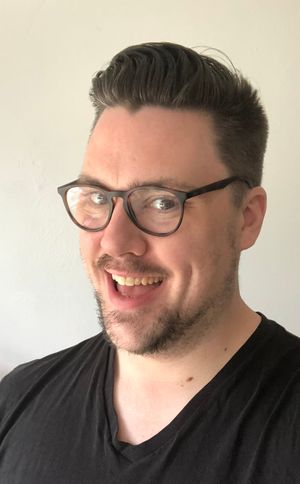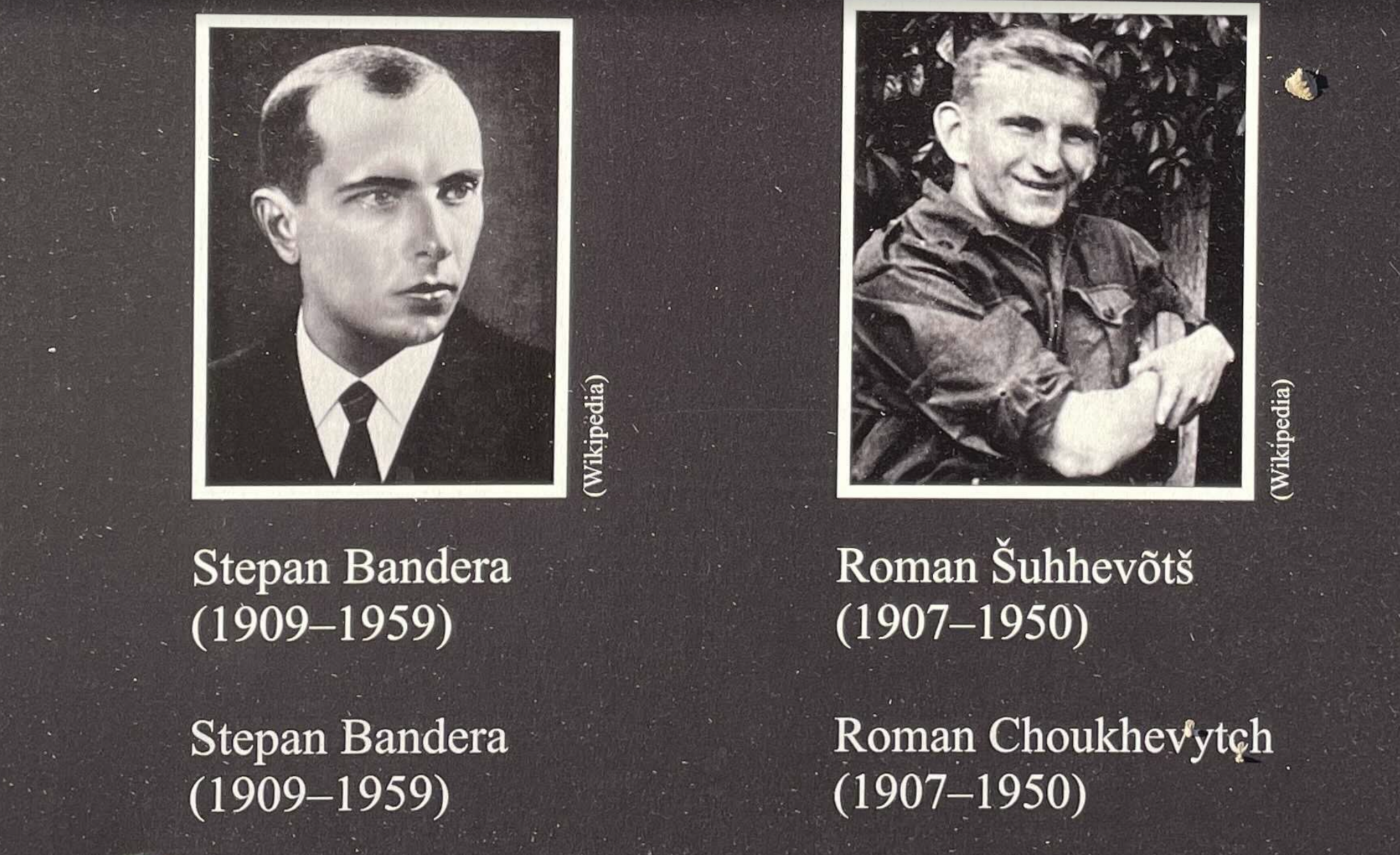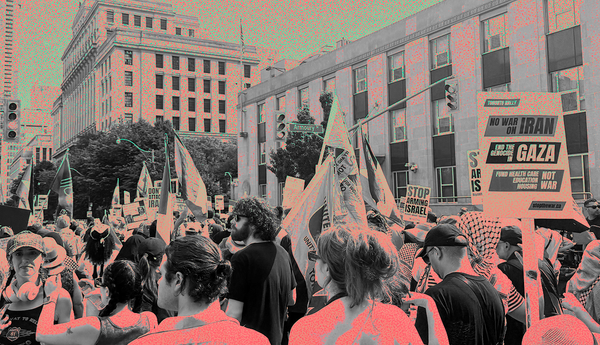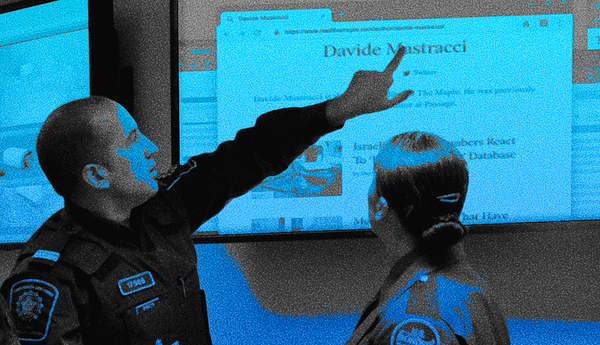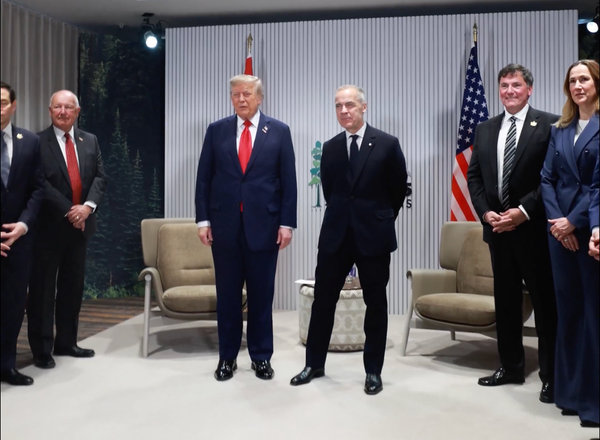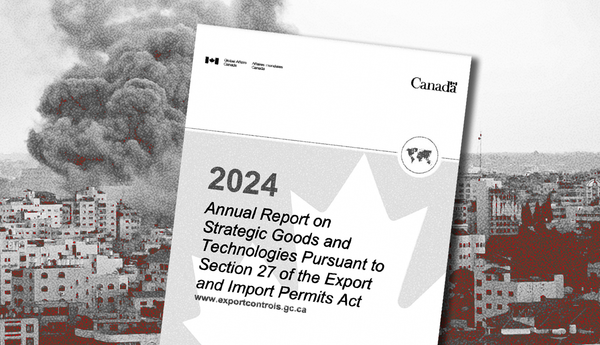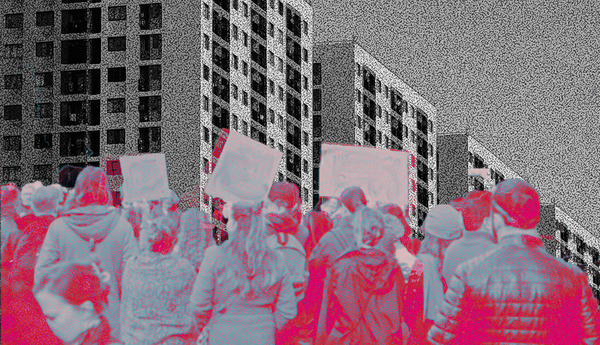Posters featuring images of wartime Ukrainian fascist leaders Stepan Bandera and Roman Shukhevych have been fixed to the side of a downtown Toronto building since at least October.
The posters, part of a series purporting to explain the history of Ukraine in the twentieth century, are attached to the side of the Tartu College student residence, located on the north side of Bloor Street near the intersection of Madison Avenue, in Toronto’s Annex neighbourhood. Also pictured on the posters is the red and black banner of the Ukrainian Insurgent Army (UPA), a nationalist paramilitary group.
The residence is within close proximity of several synagogues.
The first poster in the series features the logos of several organizations that appear to have sponsored the posters. These include the Estonian Central Council of Canada (ECCC), Estonian Museum Canada (EMC), the Estonian Institute of Historical Memory (EIHM), and the Central and Eastern European Council in Canada (CEECC).
Tartu College also houses the Tartu Institute, an Estonian cultural organization that serves the Estonian diaspora community in Canada.
One of the posters is titled “The struggle of the Ukrainian people in World War II.” According to Per Anders Rudling, an associate professor of history at the University of Lund in Sweden, the poster takes a nationalist perspective and omits key details about the two Ukrainian ultra-nationalists — Bandera and Shukhevych — whose photos appear on the poster’s lower left-hand corner.
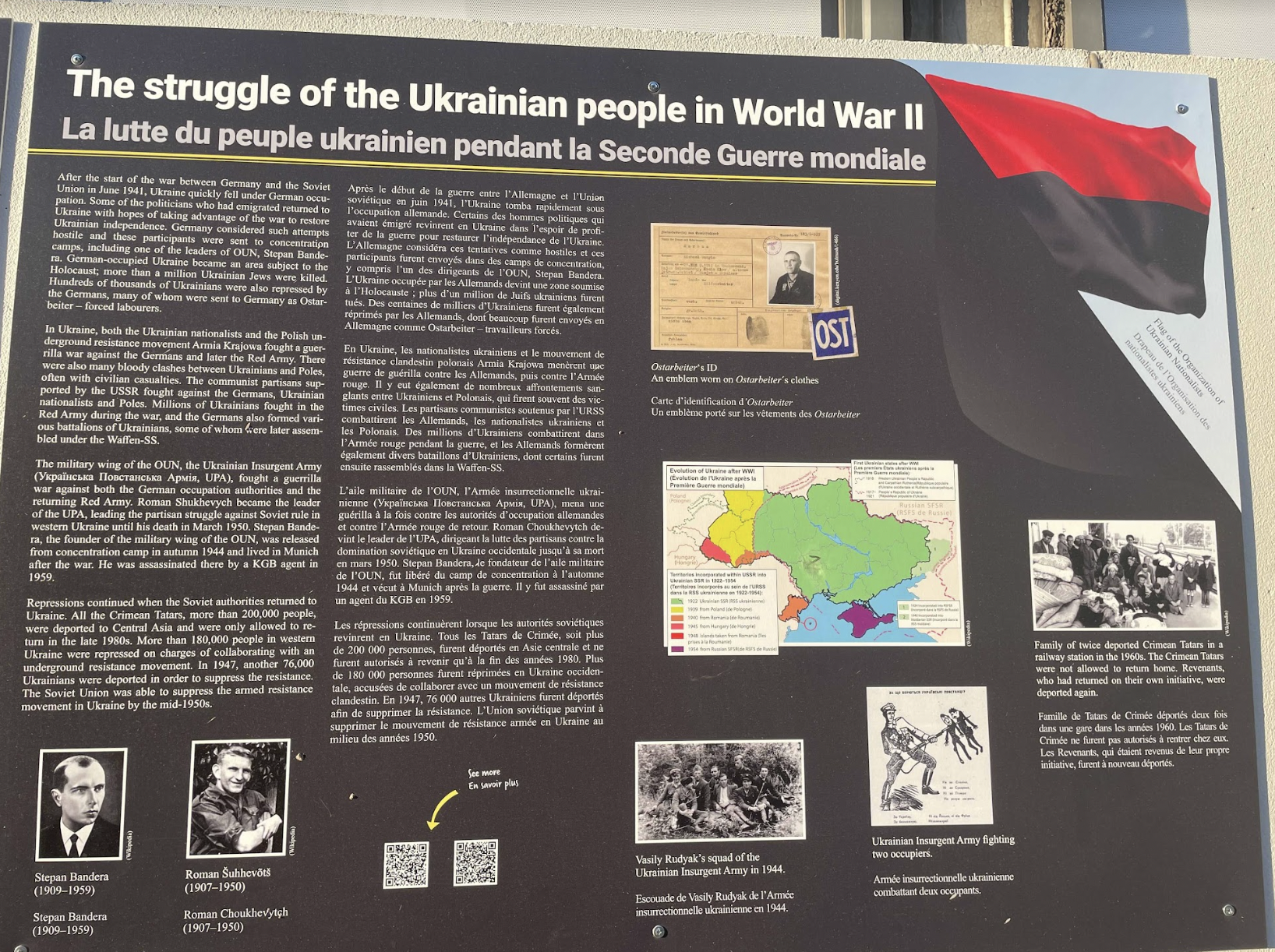
Bandera and Shukhevych are widely considered to have been responsible for the massacre of Poles in Volhynia and Eastern Galicia, carried out by the Ukrainian Insurgent Army (UPA) in Nazi-occupied territories between 1943 and 1945.
Prior to that, Shukhevych is believed to have participated in massacres of Jews, as well as Russian, Belarusian, and even other Ukrainian partisans, while serving as a commander of the Nazi-aligned Nachtigall Battalion.
The poster notes that some "Ukrainians" were “assembled under the Waffen-SS” during the war, but does not mention Bandera and Shukhevych’s complicity in genocide.
“There are no explicit lies on the poster,” Rudling told The Maple. “In that way, it mirrors, paradoxically, the Soviet narration. What is missing is what they call in Ukrainian a ‘nedomovka,’ an untranslatable word meaning ‘not telling the full story.’”
Rudling points to the following text on the poster as an example:
"Some of the politicians who had emigrated returned to Ukraine with hopes of taking advantage of the war to restore Ukrainian independence. Germany considered such attempts hostile and these participants were sent to concentration camps, including one of the leaders of the OUN, Stepan Bandera."
According to Rudling, while these emigres did return to Ukraine, what isn’t made explicit is that they came from Nazi-occupied Poland.
“Shukhevych returned to Ukraine in a German uniform, as an officer in an embedded Wehrmacht (German Army) unit,” said Rudling. Bandera stayed in Nazi-occupied Poland.
As to whether attempts by the ultra-nationalists to create an independent Ukrainian state were hostile to Nazi Germany, Rudling said this is debatable.
“The declaration of statehood declared an open support for Nazi Germany, Hitler, and the ‘New Order,’” he explained. “It was not hostile; on the contrary. It went further than the Slovak and Ustaše (Croatian fascist puppet regime) declarations of statehood.”
Nonetheless, the proclamation of an independent, albeit Nazi-affiliated, Ukrainian state in 1941 ultimately resulted in Bandera running afoul with the Nazis. While Bandera was sent to a Nazi concentration camp, where he was held with other important political prisoners, his experience differed from those of other prisoners.
“Banderite apologists love to present the Ukrainian ultra-nationalists as having shared the same plight as the Jews. They did not,” said Rudling. “About 200 Banderites were sent to Auschwitz, as an example, and of this number, about 30 died in the camp. A survival rate of 85 per cent in Auschwitz is very high, and cannot be compared to that of Jews.”
According to Rudling, Bandera had a furnished apartment at Sachsenhausen concentration camp, and was permitted conjugal visits, which led to the birth of his son Andrii in 1944.
“This was not the case for typical inmates,” said Rudling. “To present Bandera as somehow sharing the plight of the Jews is, again, identity theft and a deliberate distortion of the Holocaust beyond recognition.”
Rudling said the poster’s narrative, setup and illustrations echo the version of Ukraine’s wartime history propagated by Volodymyr Viatrovych’s Center for the Study of the Liberation Movement in Lviv. That organization, Rudling explained, is partly funded by Bandera followers in Toronto.
Viatrovych is a popular Ukrainian ultra-nationalist historian who has been accused of whitewashing Ukraine’s historical record, particularly in regard to the involvement of Ukrainian nationalists in the Holocaust and genocidal campaigns against Poles.
The “Banderite movement” — the name given to modern-day followers of Stepan Bandera — is particularly active in Ukrainian nationalist circles in Canada. Journalist Moss Robeson has compiled considerable research on the Banderites in Canada, including photos of Ukrainian nationalist groups posing in front of photos of Bandera and a bust of Shukhevych located at a Ukrainian cultural centre in Edmonton.
According to Robeson’s reporting, Paul Grod, a former leader of the Ukrainian Canadian Congress, argued the Canadian government should recognize the UPA and OUN as “designated resistance fighters” and that their pensions should be covered by Canadian taxpayers. Grod sits on the board of directors of “Tribute to Liberty,” the organization behind Ottawa’s “Victims of Communism” monument.
The Maple reached out to Jaan Meri, who is listed as the Estonian Studies Centre president on the website of the Estonian Museum Canada, which appears to be based at the Tartu Institute and located in the Tartu College building. The Maple asked Meri about the inclusion of Bandera and Shukhevych on the posters, as well as the aspects of Ukrainian wartime history that were glossed over.
Meri stated:
“The exhibit tells the story in five panels of the struggles of the Ukrainian people over the past century for their national independence. The exhibition was designed by the Estonian Institute of Historical Memory whose mission is research and education on totalitarian regimes and ideologies. The two figures that you mention are historical figures in the Ukrainian struggle against both Nazi and Soviet occupations.”
When pressed on the issue of Shukhevych, Bandera and the OUN-B and UPA’s wartime record — including their involvement in the mass murder of Jews, Poles and other groups — Meri suggested The Maple contact the Estonian Institute of Historical Memory. The institute did not reply.
Prominent leaders of Canada’s Jewish community were not impressed by the posters. Bernie Farber, formerly the CEO of the Canadian Jewish Congress and presently the chair of the Canadian Anti-Hate Network, said the poster’s omissions erase the complexity of Ukrainian-Jewish relations.
“There were times of peace and prosperity, where Jewish Rabbinical schools flourished, and relations, though strained, were not murderous,” Farber told The Maple. “Other times were cruel and brutal, with Jews subjected to pogroms and murdered in the thousands.”
“Too many Ukrainian nationals aided the Nazis in the genocidal murder of Jews by the hundreds of thousands during the Holocaust,” he added. “This poster tells only part of a difficult history between these two peoples.”
Farber said the omissions are a betrayal of both the past and present, given that Ukrainian President Volodymyr Zelenskyy is Jewish, his grandfather fought in the Red Army against the Nazis, and his great-grandparents and other relatives perished in the Holocaust.
“Ukrainians and Jews have much work left to do in order to bring both nations peace,” said Farber. “Posters such as these are misleading and unhelpful in that needed work.”
Marvin Rotrand, national director of B’nai Brith Canada’s League for Human Rights, said that while his organization is proud to support the people of Ukraine in their struggle against Russia’s invasion, they are “not blind to Ukraine’s antisemitic past.”
“Anyone who lauds Stepan Bandera and Roman Shukhevych whitewashes the murderous brutality of the far-right Ukrainian ultra-nationalist movements, particularly the OUN-B and UPA,” Rotrand told The Maple.
Efforts by Ukrainian nationalist politicians to elevate Shukhevych and Bandera to the status of national heroes by renaming places and spaces after them has caused considerable tension between Ukraine and Poland and Israel over the past two decades.
While the two men have been reclassified as “controversial” by some major media outlets in recent years in an apparent effort to maintain journalistic neutrality, the wartime records of these men, and the organizations they led, are clear to Rotrand.
“Bandera's OUN-B was a fascist, racist and antisemitic organization involved in terrorism before the Second World War,” he explained, also noting the group's collaboration with Nazi Germany at times during the war.
“Shukhevych was implicated in the massacres of thousands of Jews in Lviv from the moment the Nazis entered the city in late June 1941, and the UPA’s main actions throughout the war were the massacre of Jews and Poles,” he continued. “These organizations were motivated by hate of other ethnicities, races and religions, obsessed with violence, and contemptuous of democracy and liberalism.”
“Those who glorify these two men and their organizations, do so to the eternal shame of the Ukrainian people, and they undermine the support that the Western democracies give to Ukraine at its time of great need.”
One of the people involved in the exhibition is Marcus Kolga, a journalist, documentary filmmaker and commentator on Eastern European affairs. On an Oct. 20, 2022 episode of Kontakt Ukrainian TV, Kolga was interviewed in front of the Tartu College building. In their introductory exchange, the interviewer refers to Tartu College as “your (Kolga’s) building,” to which Kolga responds: “That’s right, and our exhibition.”
Kolga is a senior fellow with the Macdonald-Laurier Institute (MLI) and the director of MLI’s DisinfoWatch.org. On the MLI website, Kolga is listed as a “leading Canadian expert on Russian, Central and Eastern European issues.” His LinkedIn page lists an undergraduate degree in political science from the University of Illinois.
Kolga is president emeritus of the ECCC and president of the CEECC. ECCC lists Tartu College as its mailing address. Kolga was added to the board of directors of Tribute to Liberty in September 2022.
On his MLI webpage, Kolga is described as having spearheaded the effort to recognize August 23 as “Black Ribbon Day,” which commemorates victims of both communism and Nazism, in Canada. Kolga takes credit for drafting a parliamentary resolution which was subsequently introduced and passed by Bob Rae, who currently serves as Canada’s ambassador to the United Nations.
Black Ribbon Day commemorations have been initiated and championed by the ECCC as far back as the mid-1980s. Markus Hess, founder of the International Black Ribbon Day Committee, played an active role in promoting the idea.
Hess and Kolga were also both active in the CEECC’s efforts to spread the commemoration of Black Ribbon Day, as both were listed as media contacts on a CEECC press release issued in 2011 (and hosted on the website of the Ukrainian Canadian Congress).
Kolga did not reply to multiple requests for comment about the exhibit. Tartu College similarly did not answer questions about it.
Advocates of Black Ribbon Day suggest that two genocides occurred in Europe in the middle decades of the twentieth century — one committed by the Nazis, and another committed by the Soviet Union.
Critics of this “double genocide” theory argue that equating the victims of Nazism with those of communism puts the victims and perpetrators of genocide on an even footing.
Efraim Zuroff, a prominent Nazi hunter with the Simon Wiesenthal Centre in Jerusalem, has described it as a false equivalency that has the aim of covering up Eastern European complicity in the Holocaust.
In a 2017 article for Jewish Currents, scholar Dovid Katz called the “double genocide” theory the “new and official form of Holocaust denial,” particularly as it applies to post-Communist Eastern European nations that have attempted to whitewash their wartime historical record.
Rotrand voiced a similar concern: “Efforts to rehabilitate these fascist sympathizers, who spilled oceans of blood, is an assault on the memory of their victims and perpetuates antisemitism.”
Rotrand also repeated his organization’s demands that a monument honouring Shukhevych at the Ukrainian Youth Unity Complex in Edmonton be removed, along with another honouring Ukrainian SS volunteers in the 14th Waffen Grenadier Division at the St. Volodymyr Ukrainian Cemetery in Oakville, Ontario.
Taylor C. Noakes is an independent journalist and public historian from Montreal.
Go deeper
Here are a few stories from our archive that expand on today's story
Canada Refers Allegations of Russian War Crimes to International Court
The ICC prosecutor said: “I am satisfied that there is a reasonable basis to believe that both alleged war crimes and crimes against humanity have been committed in Ukraine.”
Canadian Military Makes Unsubstantiated Claim About Report Exposing Training of Ukrainian Far-Right Extremists
The Canadian military is claimed — without specific evidence or examples — that a report linking Ukrainian far-right extremists to a NATO training program contained Facebook photos that were “doctored” to support “Russian disinformation."
Top Maple story this week
Forty-Two Percent of Ontario Condos Are Used As Investment Properties

Data published by Statistics Canada this week shows that a significant number of residential properties across the country are owned as investment assets, meaning they are used to generate income rather than as primary residences.
Catch up on our latest stories
- Voices of Support for Elghawaby Grow After Calls for Her Resignation.
- Interview: Why Privatization Won't Solve The Public Health System Crisis.
- From The Readers: How Soaring Grocery Prices Affect You While Companies Rake In Profits.

